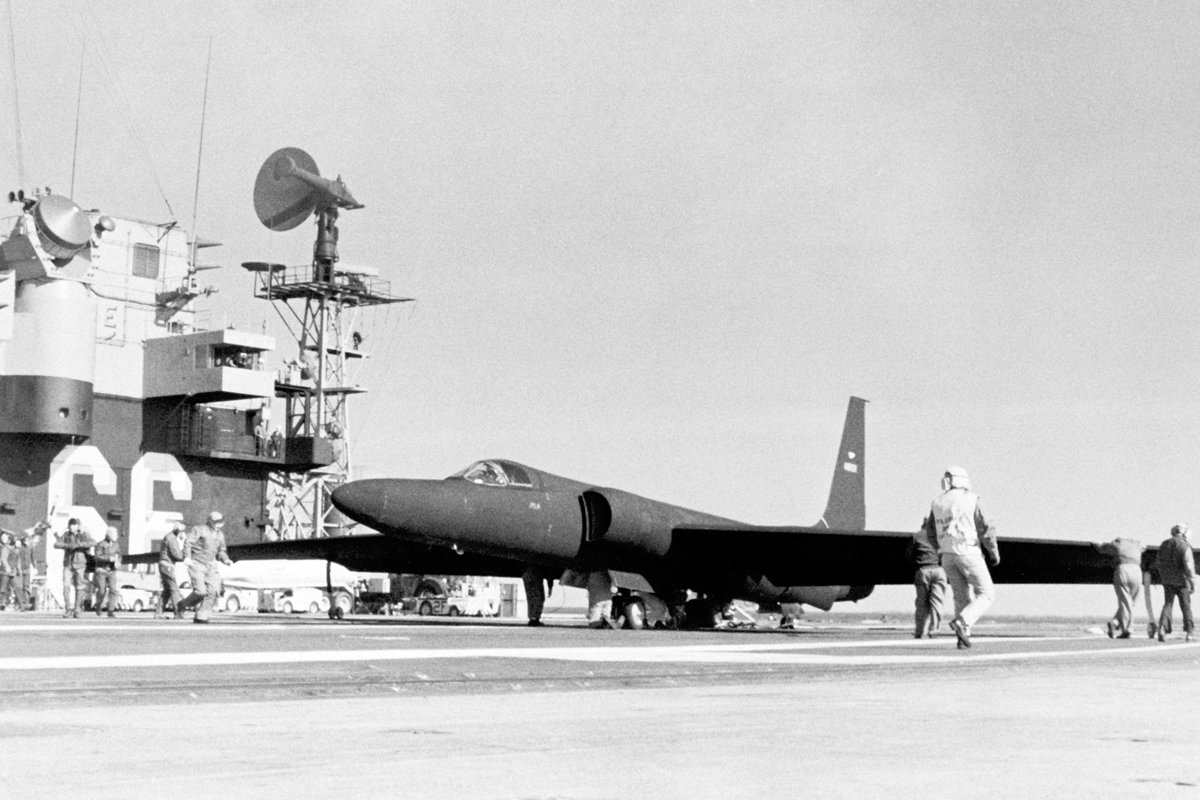Project Whale Tale: Why U-2 Spy Planes Trained To Fly From Aircraft Carriers

A left front view of a U-2 reconnaissance aircraft parked on the flight deck of the aircraft carrier USS America. Photo courtesy of Wikimedia Commons.
After a Soviet surface-to-air missile shot down a U-2 spy plane piloted by Francis Gary Powers in May 1960, US officials halted surveillance flights over the Soviet Union. The lost intelligence capability frustrated Chief of Naval Operations Adm. Arleigh Burke. One solution, which Burke recommended to Director of Central Intelligence Allen Dulles, was to begin launching modified U-2 spy planes from aircraft carriers.
The suggestion prevented a political snafu between the US and allied nations who were nervous about igniting Cold War hostilities with Moscow. Instead of negotiating new land base agreements in the face of Soviet backlash, the CIA approached Lockheed Martin to covertly modify its coveted spy plane. This plan would keep the intelligence asset in action, while also guaranteeing global access to perform clandestine surveillance missions.
The idea, however, needed time to be put into action.

In 1963, Lockheed Martin’s Skunk Works division, which was led by engineering prodigy and U-2 designer Clarence “Kelly” Johnson, conducted the first carrier operation test. Code-named Project Whale Tale, a prototype U-2 took off from the deck of the USS Kitty Hawk on Aug. 3, 1963. The flight, which occurred off the coast of San Diego, went without incident until the spy plane circled to land. The aircraft bounced hard and hit the carrier deck, damaging a wing.
According to a CIA account of the Project Whale Tale test flight: “The test convinced Johnson that the fragile U-2 needed airframe reinforcement, strengthened landing gear, and an arrestor hook like other carrier-based aircraft. In addition, the carrier version of the plane would need ‘spoilers’ on the wings to cancel the aerodynamic lift once the aircraft flew over the carrier deck.”
The engineers made their modifications. Only seven months after the first test, CIA pilots took to the air once more, now flying the U-2G spy plane. The first fully successful carrier flight test occurred on March 2, 1964.
Soon thereafter, the first real-world application of the carrier-based U-2 spy plane took place. France had just announced its intention to detonate a hydrogen device at a nuclear test area in the Mururoa Atoll, in French Polynesia. Despite the State Department’s recommendation to ground all U-2 flights, President Lyndon B. Johnson approved a single, carrier-based U-2 surveillance mission ahead of the French test.
Instead of the USS Kitty Hawk, the Navy decided that the USS Ranger would provide the staging area for the operation code-named Operation Fish Hawk.
According to the CIA: “The CIA’s National Photographic Interpretation Center (NPIC) assigned a photo interpreter to process and analyze the U-2-collected imagery on board the USS Ranger, and the Navy set up a photography lab for rapid film development and analysis on the ship for this mission. The U-2G took off successfully on 19 May 1964, but cloud cover obscured a number of the targets, so a second mission was authorized for 23 May. This sortie succeeded brilliantly, capturing high-quality photographs of all targets.”
The after-action report declared that the mission “was one of the most successful operations of this nature ever conducted by the United States.”
Despite subsequent attempts to modify the U-2, space-based reconnaissance platforms ultimately supplanted many of the spy plane’s technological capabilities.
Read Next: 4 Declassified Facts About Lockheed Martin’s Legendary ‘Skunk Works’

Matt Fratus is a history staff writer for Coffee or Die. He prides himself on uncovering the most fascinating tales of history by sharing them through any means of engaging storytelling. He writes for his micro-blog @LateNightHistory on Instagram, where he shares the story behind the image. He is also the host of the Late Night History podcast. When not writing about history, Matt enjoys volunteering for One More Wave and rooting for Boston sports teams.
BRCC and Bad Moon Print Press team up for an exclusive, limited-edition T-shirt design!
BRCC partners with Team Room Design for an exclusive T-shirt release!
Thirty Seconds Out has partnered with BRCC for an exclusive shirt design invoking the God of Winter.
Lucas O'Hara of Grizzly Forge has teamed up with BRCC for a badass, exclusive Shirt Club T-shirt design featuring his most popular knife and tiomahawk.
Coffee or Die sits down with one of the graphic designers behind Black Rifle Coffee's signature look and vibe.
Biden will award the Medal of Honor to a Vietnam War Army helicopter pilot who risked his life to save a reconnaissance team from almost certain death.
Ever wonder how much Jack Mandaville would f*ck sh*t up if he went back in time? The American Revolution didn't even see him coming.
A nearly 200-year-old West Point time capsule that at first appeared to yield little more than dust contains hidden treasure, the US Military Academy said.












